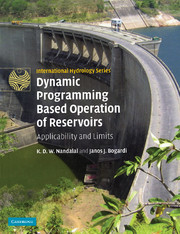Book contents
- Frontmatter
- Contents
- List of figures
- List of tables
- Preface
- 1 Water resources management
- 2 Incremental dynamic programming in optimal reservoir operation
- 3 Stochastic dynamic programming in optimal reservoir operation
- 4 Optimal reservoir operation for water quality
- 5 Large-scale reservoir system operation
- 6 Optimal reservoir operation for flood control
- References
- Index
2 - Incremental dynamic programming in optimal reservoir operation
Published online by Cambridge University Press: 14 August 2009
- Frontmatter
- Contents
- List of figures
- List of tables
- Preface
- 1 Water resources management
- 2 Incremental dynamic programming in optimal reservoir operation
- 3 Stochastic dynamic programming in optimal reservoir operation
- 4 Optimal reservoir operation for water quality
- 5 Large-scale reservoir system operation
- 6 Optimal reservoir operation for flood control
- References
- Index
Summary
Very often reservoirs are built and operated to satisfy water quantity requirements such as irrigation or drinking water consumption, hydropower production, etc. Operation of these reservoirs is vital to maximize benefits and DP in various forms can be applied for this purpose. This chapter illustrates the applicability of several different forms of incremental dynamic programming (IDP) in the derivation of optimal operation patterns for different reservoir systems.
IDP IN OPTIMAL RESERVOIR OPERATION: SINGLE RESERVOIR
Dynamic programming can be applied to derive optimal operation policies for a single reservoir. Use of conventional DP in this task is one possibility. This section shows the application of IDP for two reservoir systems: (a) the Kariba Reservoir in Zambia and Zimbabwe, and (b) the Ubol Ratana Reservoir in Thailand, based on the analysis of Budhakooncharoen (1986, 1990). The IDP technique, which considers only a limited state space at a time, has lower computer storage requirements.
Application of IDP to the Kariba Reservoir
The Kariba Reservoir is a single-unit water resource system that utilizes the water resource of the Zambezi River to produce hydroelectric energy. The Zambezi River rises in northern Zambia. After flowing through Angola, it forms the boundary between Zambia and Zimbabwe. Finally, it passes through Mozambique to discharge into the Indian Ocean north of Beira. Figure 2.1 shows the Zambezi River basin. The catchment area of the basin up to the Kariba Dam is about 665 600 km2. The Kariba Reservoir is shared and operated by CAPCO (Central African Power Corporation).
Information
- Type
- Chapter
- Information
- Dynamic Programming Based Operation of ReservoirsApplicability and Limits, pp. 16 - 30Publisher: Cambridge University PressPrint publication year: 2007
Accessibility standard: Unknown
Why this information is here
This section outlines the accessibility features of this content - including support for screen readers, full keyboard navigation and high-contrast display options. This may not be relevant for you.Accessibility Information
- 6
- Cited by
